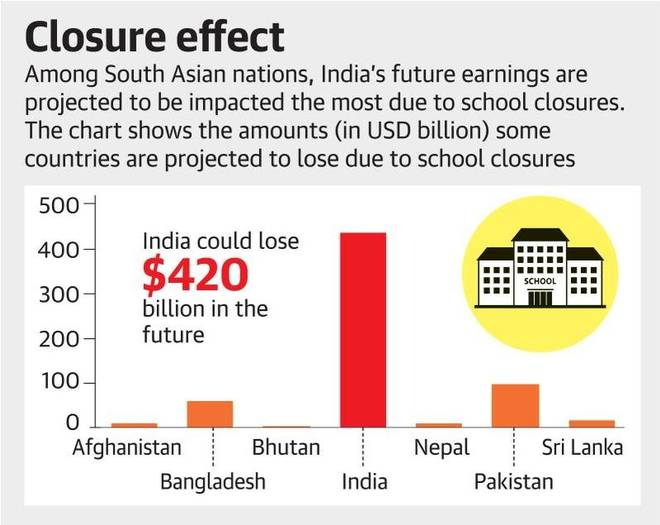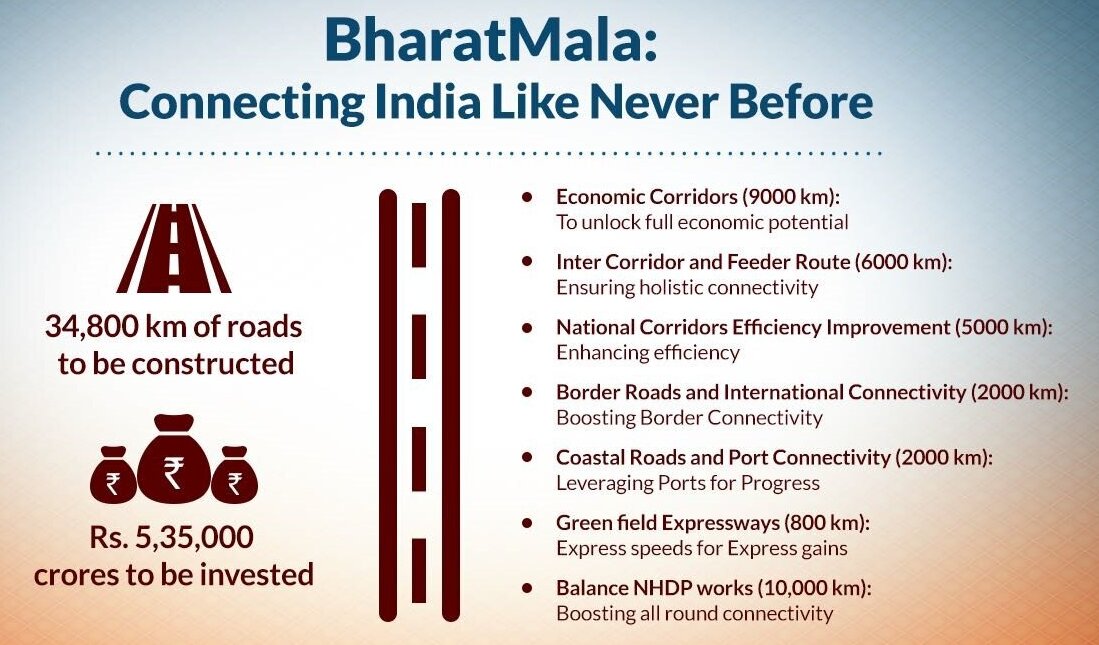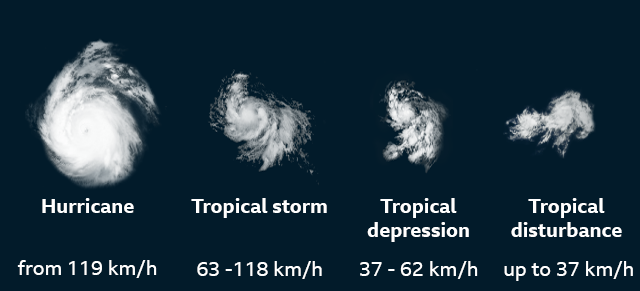Social Justice
15 Years of RTI
Why in News
A report by the Satark Nagrik Sangathan and the Centre for Equity Studies has pointed out that more than 2.2 lakh Right to information cases are pending at the Central and State Information Commissions (ICs), which are the final courts of appeal under the RTI Act, 2005.
- The report was released on the occasion of completion of the 15 years of Right to Information (RTI) Act.
Key Points
- Unavailability during Covid-19 lockdown: Out of the total 29 ICs that were studied, 21 were not holding any hearings.
- Even the websites of 3 ICs -Bihar, Madhya Pradesh and Nagaland -were not accessible during the lockdown.
- Websites of 11 commissions out of 29, had no information/notification about the functioning of the IC during the lockdown.
- Reduced Capacity: Of the 29 ICs, two ICs -Jharkhand and Tripura -were found to have no commissioners for varying lengths of time. They were completely defunct.
- 4 were functioning without a Chief Information Commissioner -Bihar, Goa, Rajasthan and Uttar Pradesh.
- Under the RTI 2005 act, every commission should have a chief and up to 10 commissioners.
- Delays and Backlogs: The assessment found that on average, the CIC takes 388 days (more than one year) to dispose of an appeal/complaint from the date that it was filed before the commission.
- The highest number of pending appeals, with over 59,000 cases were in Maharashtra, followed by Uttar Pradesh and the Central Information Commissions (CIC).
- No Penalties: The report found that the Government officials face hardly any punishment for violating the law.
- Penalties were imposed in only 2.2% of cases that were disposed of, despite previous analysis showing a rate of about 59% violations which should have triggered the process of penalty imposition.
Right to Information (Amendment) Act, 2019
- It provided that the Chief Information Commissioner and an Information Commissioner (of Centre as well as States) shall hold office for such term as prescribed by the Central Government. Before this amendment, their term was fixed for 5 years.
- It provided that the salary, allowances and other service conditions of the Chief Information Commissioner and an Information Commissioner (of Centre as well as States) shall be such as prescribed by the Central Government.
- Before this amendment, the salary, allowances and other service conditions of the Chief Information Commissioner were similar to those of the Chief Election Commissioner and that of an Information Commissioner were similar to those of an Election Commissioner (State Election Commissioners in case of States).
- It removed the provisions regarding deductions in salary of the Chief Information Commissioner, an Information Commissioner, the State Chief Information Commissioner and a State Information Commissioner due to pension or any other retirement benefits received by them for their previous government service.
- The RTI (Amendment) Act, 2019 was criticized on grounds of diluting the law and giving more powers to the central government.
Central Information Commission
- Established: The Central Information Commission was established by the Central Government in 2005, under the provisions of the Right to Information Act (2005). It is not a constitutional body.
- Members: The Commission consists of a Chief Information Commissioner and not more than ten Information Commissioners.
- At present (2019), the Commission has six Information Commissioners apart from the Chief Information Commissioner.
- Appointment: They are appointed by the President on the recommendation of a committee consisting of the Prime Minister as Chairperson, the Leader of Opposition in the Lok Sabha and a Union Cabinet Minister nominated by the Prime Minister.
- Tenure: The Chief Information Commissioner and an Information Commissioner shall hold office for such term as prescribed by the Central Government or until they attain the age of 65 years, whichever is earlier.
- They are not eligible for reappointment.
- Power and Functions of CIC
- It is the duty of the Commission to receive and inquire into a complaint from any person regarding information request under RTI, 2005.
- The Commission can order an inquiry into any matter if there are reasonable grounds (suo-moto power).
- While inquiring, the Commission has the powers of a civil court in respect of summoning, requiring documents etc.
Suggestions
- The government must ensure the timely appointment of chiefs and members of ICs.
- The increasing backlog of cases is exacerbated by the fact that most Commissions are functioning at reduced capacity.
- It is absolutely critical that all information commissions conduct timely and effective hearings and disposal of cases to ensure people can exercise their fundamental right to information.
- Commissions should hold hearings telephonically. Where possible, video calls can be set up.
- There should be a prioritization of cases dealing with information related to life and liberty. Information regarding matters like food distribution, social security, health and COVID 19-related issues should be proactively disclosed.
- Section 7(1) of the RTI Act states that information concerning the life or liberty of a person has to be supplied within 48 hours of the request being received.
- Section 4 of the RTI Act requires suo motu disclosure of information by each public authority.
- Urgent digitization of records and proper record management is important as lack of remote access to records in the lockdown has been widely cited as the reason for not being able to conduct hearings of appeals and complaints by commissions.
- Governments should put in place a mechanism for online filing of RTI applications.
Way Forward
- The role of information commissions is crucial during Covid-19 to ensure that people can obtain information on healthcare facilities, social security programs and delivery of essential goods and services meant for those in distress.
- If the poor and marginalised affected by the public health emergency are to have any hope of obtaining the benefits of government schemes, they must have access to relevant information.
- Democracy is all about the governance of the people, by the people and for the people. In order to achieve the third paradigm, the state needs to start acknowledging the importance of informed public and the role that it plays in the country’s development as a nation. In this context, underlying issues related to RTI Act should be resolved, so that it can serve the information needs of society.
Social Justice
South Asia Economic Focus Report: World Bank
Why in News
The World Bank has recently released its biennial South Asia Economic Focus report. The fall 2020 edition is titled “Beaten or Broken? Informality and Covid-19”.
- The report includes Afghanistan, Bangladesh, Bhutan, India, Maldives, Nepal, Pakistan and Sri Lanka.
- The report predicts that the extended closure of schools amid the Covid-19 pandemic could dent India’s future earnings by anywhere between 420 billion USD and 600 billion USD, as depleted learning levels of students will translate into poorer productivity going forward.
Key Points
- Impact on Education:
- Around 5.5 million students could drop out of schools across South Asia.
- 391 million students have been kept out of school in primary and secondary education due to lockdown.
- Dropouts, combined with substantial learning losses for those who remain enrolled in schools, would cost South Asia as much as 622 billion USD in future earnings and gross domestic product.
- The regional loss is largely driven by India, all countries will lose substantial shares of their GDP.
- The projected learning loss for the region is 0.5 years of learning-adjusted years of schooling (LAYS) at present.
- LAYS combines quantity and quality of schooling into a single easy-to-understand metric of progress.
- Due to the closure of schools, not only the learning process has been obstructed but the children may have forgotten their previous learnings.
- The average child in South Asia may lose 4,400 USD in lifetime earnings once having entered the labour market, equivalent to 5% of total earnings.
- Engaging children through remote learning programmes had been difficult, despite most governments’ best efforts to mitigate the impact of school closures.
- Impacts on Economy:
- Impact on Informal Sector: The report has flagged damage to businesses, consumption patterns and imposed social hardship on poor and vulnerable households, especially urban migrants and informal workers in the South Asia region. It has also warned against far-reaching consequences apart from these immediate impacts.
- GDP: The regional GDP of the South Asia region is estimated to contract by 7.7% in 2020.
- India’s Gross Domestic Product (GDP) can contract by 9.6% in 2020-21.
- Labour productivity: It will also take a greater hit from Covid-19 than most previous natural disasters. Reasons for the decrease in labour productivity are as follows:
- Globalization: The increased integration of the global economy will amplify the adverse impact of Covid-19. Effect on supply chains, export-import and international migration of labour will affect labour productivity.
- Capacity underutilization: Contagion prevention and physical distancing may render some activities, for example, the hospitality sector, unviable unless they are radically transformed, which will take time. Even in less directly affected sectors such as manufacturing, banking and business, severe capacity underutilisation lowers total factor productivity.
- Disruptions to training, schooling and other education: These may occur due to severe income losses as well as lack of access to training and education facilities. Even once restrictions are lifted, the impediment of training will also lower human capital and labour productivity over the long term.
- Other Related Reports:
- Recently, the UN Report on the Impact of Covid-19 on Children estimated that almost 24 million children could drop out or not have access to school next year due to the economic impact of Covid-19.
- Earlier this year, the Global Education Monitoring Report, 2020 was released by UNESCO which highlighted that the Covid-19 had worsened the inequalities in education systems worldwide.
Way Forward
- To avoid the outcome of the pandemic, progress on three fronts is required: Information, Solidarity and Action.
- It is critical that education is at the heart of international solidarity efforts, from debt management and stimulus packages to global humanitarian appeals and official development assistance.
- It is the time to step up international solidarity for children and humanity— and to lay the foundations for a deeper transformation of the way we nurture and invest in our world’s youngest generation.
- India as a lower-middle-income country needs to use education as an equalizer for its widespread socioeconomic inequalities. Focus on increasing the education budget in the New Education Policy and decreasing the digital divide are welcome steps to achieve this goal.
Biodiversity & Environment
IIT Delhi’s Study on Ultrafine Particles
Why in News
A study titled ‘Insights on the biological role of ultrafine particles of size PM<0.25: a prospective study from New Delhi’ suggested higher cytotoxicity in human lung cells because of fractions of Particulate Matter (PM) 2.5 when compared to larger particulate matters.
Key Points
- Methodology: Data for the study was collected six times every month between January and December 2017, through a cascade impactor measurement device- for measuring fine particle size distribution- installed at IIT Delhi.
- Airborne particles in five sizes — 2.5, 1, 0.5, 0.25 and below 0.25 micrometers (µm) — were collected through the filters.
- Findings:
- Proportion of Ultrafine Particles:
- Particulate matter of below 0.25 micrometers constituted the highest share in the composition of PM2.5 around the year as compared to particles of other sizes.
- The PM<0.25 particles constituted over 40% of PM2.5 levels during the post-monsoon season and over 30% during winters and pre-monsoon periods between March and May.
- A decrease in total PM 2.5 levels may not be associated with a decrease in PM<0.25 levels.
- This suggests that total PM2.5 levels are not good indicators of PM<0.25 levels.
- Exposure to ultrafine particles of below 0.25 micrometers was also associated with over two-fold higher cytotoxicity (effect of being toxic to cells), as compared to exposure to other sizes.
- Particulate matter of below 0.25 micrometers constituted the highest share in the composition of PM2.5 around the year as compared to particles of other sizes.
- Mass Concentration: For PM particles of size up to 2.5 µm, 1.0 µm, 0.5 µm, and <0.25µm, the cumulative average mass concentration values were found to be highest for the post-monsoon season (October-December), followed by winter (January-February).
- High levels of PM2.5 are recorded in Delhi every year during post-monsoon and winter months, which in the past have led authorities to declare a public health emergency on some days and close schools.
- Reasons: The observed high levels of PM in the post-monsoon and winter months partially due to:
- Celebration of Diwali.
- Agricultural residue burning in neighbouring states of Punjab and Haryana.
- Secondary formation of particles due to favourable meteorological conditions.
- The low temperature and high humidity during winter nights enhance the fog-smog-fog cycle and result in 2-3-fold increase in PM concentration compared to pre-monsoon and South-West monsoon season.
- Proportion of Ultrafine Particles:
- Health Impacts: The adverse impact on health from chronic exposure to PM2.5 is well established — including stroke, lung cancer, and other heart and lung related problems.
- Health impact of different size fractions within PM2.5 is not well studied yet.
- The National Ambient Air Quality Standard (NAAQS) has fixed a threshold for PM2.5 at 60 µg/m3 for 24 hours and 40 µg/m3 annually, but it does not have specific policies for ultrafine particles.
- NAAQS was notified by CPCB in 2009.
- Pollutants covered under NAAQS are Sulphur Dioxide (SO2), Nitrogen Dioxide (NO2), Particulate Matter (PM 10, PM 2.5), Ozone (O3), Lead (Pb), Carbon Monoxide (CO), Ammonia (NH3), Benzene (C6H6), Benzo(a)Pyrene (BaP), Arsenic(As), Nickel (Ni).
Way Forward
- Findings demonstrate a potentially important link between PM<0.25 levels and human health.
- Work provides novel insights for policy changes in monitoring PM, especially the need to routinely monitor PM<0.25
- The necessity to start working towards establishing exposure limits for PM<0.25 when the total PM2.5 levels are breached.
Science & Technology
Factor D Protein: Covid-19
Why in News
A new study by Johns Hopkins Medicine researchers suggests that blocking a human protein factor D may curtail the potentially deadly inflammatory reactions that many patients have to the novel coronavirus (SARS-CoV-2).
Key Points
- Method: The new study used normal human blood serum and three subunits of the SARS-CoV-2 spike protein to discover exactly how the virus hijacks the immune system and endangers normal cells.
- Focus: Team focused on two proteins, factor H and factor D, which are known as “complement” proteins, because they help the immune system clear pathogens from the body.
- Findings: The researchers discovered that Covid-19’s spike protein causes factor D to overstimulate the immune response, which in turn prevents factor H from mediating that response.
- Spike proteins on the surface of SARS-CoV-2 are the means by which it attaches to cells targeted for infection.
- The spikes first grab hold of a molecule called heparan sulfate.
- Heparan sulfate is a large, complex sugar molecule found on the surface of cells in the lungs, blood vessels and smooth muscle making up most organs.
- Facilitated by its initial binding with heparan sulfate, SARS-CoV-2 then uses another cell-surface component, the protein known as angiotensin-converting enzyme 2 (ACE2), as its doorway into the attacked cell.
- ACE2 is a protein on the surface of many cell types.
- It is an enzyme that generates small proteins – by cutting up the larger protein angiotensinogen – that then go on to regulate functions in the cell.
- When SARS-CoV-2 attacks the ACE2 receptors to proliferate and infect more cells in the human body, it also prevents Factor H from using the sugar molecule to bind with cells.
- Factor H’s main function is to regulate the chemical signals that trigger inflammation and keep the immune system from harming healthy cells.
- The team found that by blocking factor D, they were able to stop the destructive chain of events triggered by SARS-CoV-2.
- Significance:
- It has provided a definite direction for research to tackle Covid-19.
- There may already be drugs in development for other diseases that can block this protein, a positive sign for the study.
Governance
Status of Bharatmala Pariyojana
Why in News
A total of 322 projects in a length of 12,413 km have been awarded and 2921 km has been constructed under Bharatmala Pariyojana till August 2020.
Key Points
- Bharatmala Pariyojana is an umbrella program for the highways sector envisaged by the Ministry of Road Transport and Highways.
- Under Phase-I of Bharatmala Pariyojana, implementation of 34,800 km of national highways in 5 years (from 2017 to 2022) has been approved at an estimated outlay of Rs. 5,35,000 crore.
- National Highways Authority of India (NHAI) has mandated the development of about 27,500 km of national highways under Phase-I.
- However, as per ICRA Limited, Phase-I is likely to be delayed by four years due to the prevailing uncertainty due to Covid-19 and consequent impact on valuations.
- ICRA Limited is an Indian independent and professional investment information and credit rating agency.
- Phase-II envisages around 48,000 km of road network across India by 2024.
- Objectives:
- To optimise the efficiency of freight and passenger movement across the country by bridging critical infrastructure gaps through effective interventions.
- The effective interventions include the development of economic corridors, inter corridors and feeder routes, national corridor efficiency improvement, border and international connectivity roads, coastal and port connectivity roads and greenfield expressways.
- Economic Corridors: These are integrated networks of infrastructure within a geographical area designed to stimulate economic development.
- Greenfield Projects: They lack constraints imposed by prior work on the site. Typically, it entails development on a completely vacant site and architects start completely from scratch.
- Brownfield Projects: They carry constraints related to the current state of the site and might be contaminated or have existing structures that architects have to tear down or modify in some way before the project can move forward.
- The effective interventions include the development of economic corridors, inter corridors and feeder routes, national corridor efficiency improvement, border and international connectivity roads, coastal and port connectivity roads and greenfield expressways.
- To generate a large number of direct and indirect employment opportunities in the construction and infrastructure sector and also as part of the enhanced economic activity resulting from better road connectivity across the country.
- To connect 550 districts in the country through national highway linkages.
- To optimise the efficiency of freight and passenger movement across the country by bridging critical infrastructure gaps through effective interventions.
- Features:
- Improvement in the efficiency of existing corridors through the development of Multimodal Logistics Parks and elimination of chokepoint.
- Multimodal Logistics Parks are a key policy initiative of the Government of India to improve the country's logistics sector by lowering overall freight costs, reducing vehicular pollution and congestion, and cutting warehousing costs.
- A chokepoint is a single point through which all incoming and outgoing network traffic is funnelled and hence, leads to congestion and traffic.
- Enhance focus on improving connectivity in North East and leveraging synergies with Inland Waterways.
- Emphasis on the use of scientific and technological planning for Project Preparation and Asset Monitoring.
- Satellite mapping of corridors to identify up-gradation requirements.
- Delegation of powers to expedite project delivery for successful completion of Phase I by 2022.
- Improvement in the efficiency of existing corridors through the development of Multimodal Logistics Parks and elimination of chokepoint.
- Project Categories:
Indian History
Jayaprakash Narayan and Nanaji Deshmukh Jayanti
Why in News
Prime Minister of India bowed to Loknayak Jayaprakash Narayan and Nanaji Deshmukh, on their Jayanti.
Key Points
- Jayaprakash Narayan (JP):
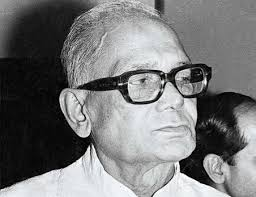
- Birth: 11th October, 1902 in Sitabdiara, Bihar.
- Influenced By: Marxist ideas in the USA and Gandhian ideology.
- Contribution to Freedom Struggle:
- In 1929, he joined the Indian National Congress.
- Imprisonment:
- In 1932 imprisoned for a year for participation in the civil disobedience movement.
- In 1939 for his opposition to Indian participation in World War II on the side of Britain but escaped.
- He played a key role in the formation of the Congress Socialist Party (1934), a left-wing group within the Congress Party.
- Post-Independence Role:
- In 1948, he left the Congress Party and initiated an anti-Congress Campaign.
- In 1952, he formed the Praja Socialist Party (PSP).
- In 1954, he devoted his life exclusively to the Bhoodan Yajna Movement, of Vinoba Bhave, which demanded land redistribution to the landless.
- In 1959 he argued for a “reconstruction of Indian polity” by means of a four-tier hierarchy of village, district, state, and union councils (Chaukhamba Raj).
- Total Revolution: Against Indira Gandhi Regime as she was found guilty of violating electoral laws by the Allahabad High Court. He advocated a program of social transformation which he termed ‘Sampoorna Kranti' (total revolution) in 1974 against corruption in public life.
- Features:
- Total Revolution has seven component revolutions, namely- political, social, economic, cultural, ideological or intellectual, educational and spiritual.
- The objective was to bring in a change in the existing society that is in tune with the ideals of the Sarvodaya (Gandhian philosophy- progress for all).
- Features:
- Bharat Ratna: Jayaprakash Narayan was posthumously conferred with India's highest civilian award, the Bharat Ratna (1999), for his "invaluable contribution to the freedom struggle and upliftment of the poor and downtrodden".
- Nanaji Deshmukh:
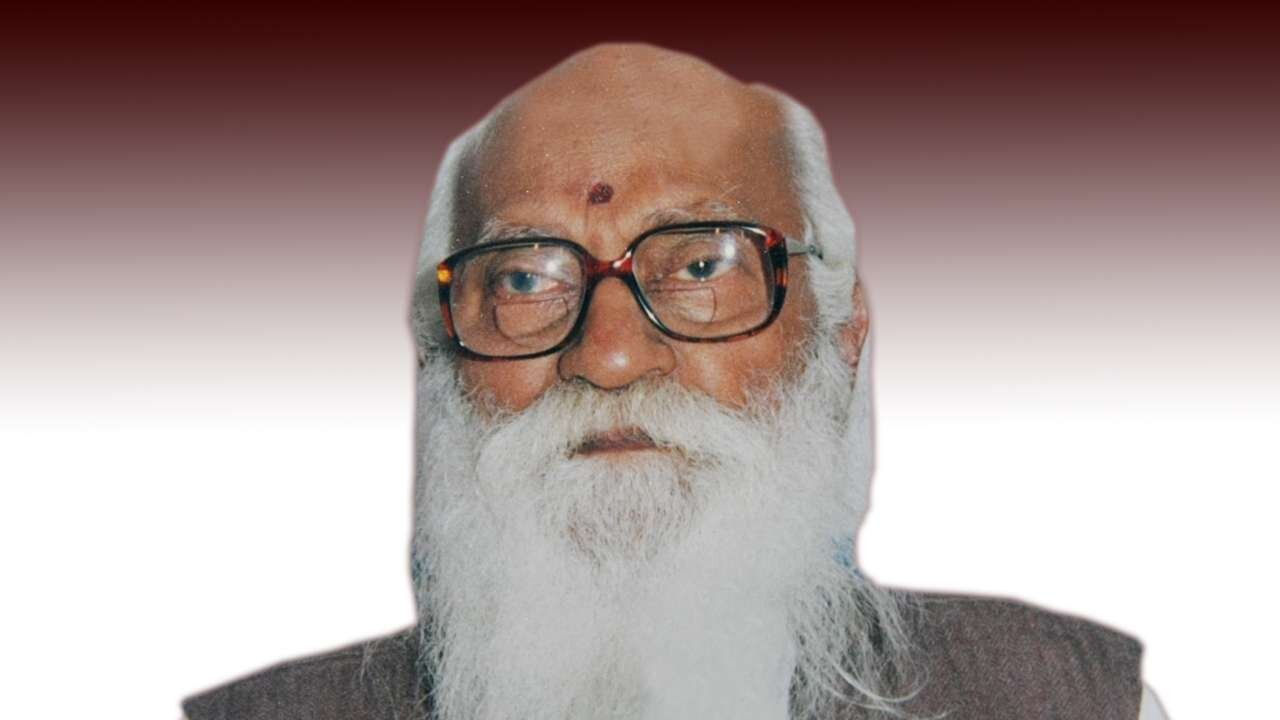
- Birth: 11th October 1916 in Maharashtra’s Hingoli district.
- Influenced by: Lokamanya Tilak and his nationalist ideology.
- Dr. Keshav Baliram Hedgewar, founding Sarsangha-chalak(head) of the Rashtriya Swayamsevak Sangh (RSS).
- He was a leader of Bharatiya Jana Sangh and Rashtriya Swayamsevak Sangh.
- Participation: He actively participated in Acharya Vinoba Bhave’s Bhoodan.
- Deshmukh was the main force behind social activist Jayaprakash Narayan's agitation for total revolution.
- Social Activism: He was a social reformer with focus on health, education and rural self-reliance.
- He established Chitarkoot Gramoday Vishwavidyalaya in Chitrakoot, India’s first rural University and had served as its Chancellor.
- He did great work towards the anti-poverty and minimum needs programme.
- Electoral Politics: He was one of main architects of the Janata Party.
- He won in the 1977 Lok election from Balrampur (UP) Lok Sabha constituency.
- He was nominated to Rajya Sabha in 1999 in recognition of his services to the nation.
- Death: 27th February, 2010.
- Awards:
- He was awarded Padma Vibhushan in 1999.
- In 2019, the President of India, conferred the Bharat Ratna upon him (posthumously) for his services to the nation.
Biodiversity & Environment
Lepidoptera Species and Climate Change
Why in News
According to a recent study, rising average temperatures in the Himalayan region have driven several dozen species of butterfly and moth to habitats higher up the mountains.
- The Himalayas are home to more than 35% of Lepidoptera species (butterflies and moths) found in India.
Key Points
- Lepidoptera:
- Lepidoptera is the order of insects that includes butterflies, moths and skippers.
- The name Lepidoptera is derived from the Greek, meaning “scaly winged,” and refers to the characteristic covering of microscopic dustlike scales on the wings.
- Due to their day-flying habits and bright colours, the butterflies are more familiar than the chiefly night-flying and dull-coloured moths, but the latter is far more varied and abundant.
- The skippers are a worldwide group intermediate between butterflies and moths.
- Importance:
- They are ecologically important because they transform large amounts of plant matter into the animal matter and in turn serve as food for many other groups of animals.
- The adults of many species are important for their role in pollination, which occurs as they visit flowers for nectar.
- About the Study:
- It was carried out by the Zoological Survey of India (ZSI) and was funded by the Ministry of Environment, Forest and Climate Change.
- The four-year study tracked 1,274 species of moth and 484 species of butterfly in Jammu and Kashmir (J&K), Himachal Pradesh, Uttarakhand, Sikkim, North Bengal, and Arunachal Pradesh.
- It also identified 80 new species of butterfly and moth.
- Findings of the Study:
- At least 49 species of moth and 17 species of butterfly have shown “considerable new upward altitude records”, with a difference of more than 1,000 metres between their current and previously recorded mean habitat altitudes.
- Few species of moths like the mulberry silkworm moth and tiger moth have started to inhabit altitudes more than 2,000 m higher than the previous mean.
- Butterflies like the Common Map, Tailless Bushblue and the Indian Red Admiral butterfly have seen the difference ranging from 900-1500 m in their habitats.
- The extension of the range of Lepidoptera due to climate change has been observed all over the world and Indian data from this evidence-based study confirms this trend and shows which species are moving, and how.
- Butterflies are sensitive species that are extremely susceptible to changes in climate. They are, therefore, good indicators of long-term change in climatic conditions.
- The ZSI predicts a decline of as much as 91% for example, in the suitable area for the Notodontidae family of moths in J&K, Himachal, and Uttarakhand by 2050.
- The findings will be used as a baseline indicator to track the impact of climate change on animal species over the coming decade.
- The study has identified two species richness hotspots:
- One is in West Bengal’s Darjeeling hills, where more than 400 species records were documented.
- Another one is in Kumaon, Uttarakhand, where more than 600 species records were found.
- The study also revealed an increase in the richness of Lepidoptera biodiversity from the Western to the Eastern Himalayas.
- At least 49 species of moth and 17 species of butterfly have shown “considerable new upward altitude records”, with a difference of more than 1,000 metres between their current and previously recorded mean habitat altitudes.
- Factors behind the Upward Movement:
- Receding ice caps and glaciers leading to a scarcity of water in the Himalayas has been a major reason for the altitudinal shift of the Lepidoptera.
- The increase in average temperature has resulted in an altitudinal shift in vegetation that once grew at lower altitudes in the Himalayas are now found only higher up in the mountains.
- Increasing human habitation has contributed to the shift as well.
- For example, Shimla and Darjeeling are two big hotspots of rich butterfly diversity but expanding towns have encroached on virgin territory, and the space for the butterfly has shrunk.
- Poaching and selling have led to the reduced or negligible population at the lower altitudes.
- Butterflies like the Red Apollo are highly prized by collectors and are often poached. One butterfly sells for up to 100 pounds on the international market.
Geography
Hurricane Delta
Why in News
Recently, Hurricane Delta made landfall in the USA state of Louisiana, which is still recovering from the damage caused by a previous hurricane (Laura) in August 2020.
Key Points
- Hurricane Delta is the 10th named storm to make USA landfall so far this year, breaking a record that has stood since 1916.
- As per the scientists, global warming is a major cause behind rapidly intensifying Atlantic hurricanes.
- Delta is also the first Greek alphabet named hurricane on record to make landfall in continental USA.
- When a very active hurricane season occurs and the list is exhausted, the Greek alphabet is used (Alpha, Beta, Gamma, Delta, Epsilon, Zeta, Eta, Theta, etc).
- It hit Louisiana as a Category 2 hurricane, but weakened to a Category 1 as it moved inland.
- Hurricanes:
- Hurricanes are the biggest and most violent storms on the planet.
- Every year, between June and November they hit the Caribbean, the Gulf of Mexico and the eastern coast of the United States, sometimes leaving a trail of destruction in their wake.
- In the western North Pacific, they are called "typhoons".
- In the Bay of Bengal and Arabian Sea, they are called "cyclones".
- In Australia, they are called “Willy-Willy”.
- Formation:
- A hurricane starts out as a tropical disturbance. This is an area over warm ocean waters where rain clouds are building.
- A tropical disturbance sometimes grows into a tropical depression. This is an area of rotating thunderstorms with winds of 62 km/hr or less.
- A tropical depression becomes a tropical storm if its winds reach 63 km/hr.
- A tropical storm becomes a hurricane if its winds reach 119 km/hr.
- Category of Hurricanes:
- Hurricanes can be classified in five categories depending on the sustained wind speeds.
- In the Atlantic, the Saffir-Simpson wind scale is used to measure their destructive power.
- Parts of a Hurricane:
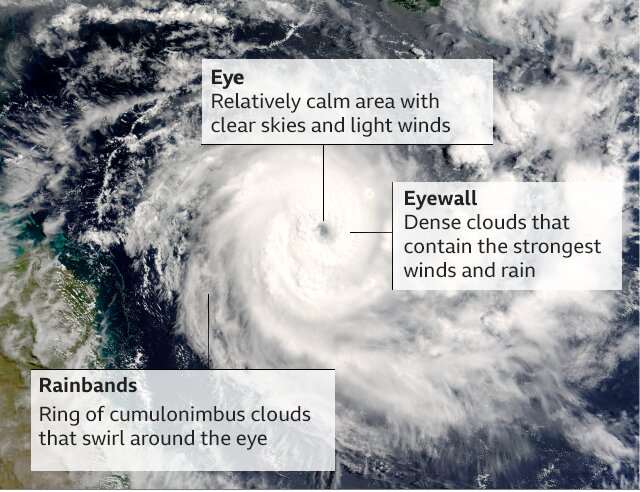
- Eye: The eye is the "hole" at the center of the storm. Winds are light in this area. Skies are partly cloudy, and sometimes even clear.
- Eye Wall: The eye wall is a ring of thunderstorms. These storms swirl around the eye. The wall is where winds are strongest and rain is heaviest.
- Rain Bands: Bands of clouds and rain go far out from a hurricane's eye wall. These bands stretch for hundreds of miles. They contain thunderstorms and sometimes tornadoes.
- Naming:
- Each year, tropical storms are named in alphabetical order. The names come from a list of names for that year. There are six lists of names. Lists are reused every six years.

